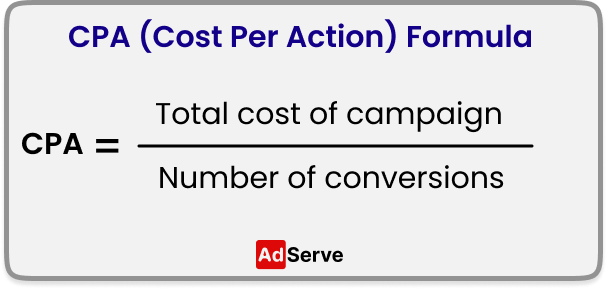What is Cost Per Action (CPA)?
Cost Per Action (CPA) in advertising is a performance-based pricing model where advertisers pay for a specific action taken by a user, rather than for impressions or clicks. This action could be a purchase, sign-up, download, form submission, or any other predefined conversion event. CPA is designed to ensure that advertisers only pay when their advertising efforts result in a measurable and desired outcome.
CPA (Cost Per Action), also known as Cost Per Acquisition, is the amount an advertiser pays for each specified action completed by a user as a result of clicking on an ad.
CPA is one of the most important performance indicators for advertisers in online advertising as it relates directly to the end goal of every business process—sales.
How to Calculate CPA?
Calculating CPA (Cost Per Action or Cost Per Acquisition) is straightforward. It involves dividing the total cost of the advertising campaign by the number of conversions (actions) achieved.
Try our CPA calculator to better understand this pricing model.
CPA (Cost Per Action) formula
CPA = Total cost of campaign / Number of conversions

Cost Per Action (CPA) calculation example
Suppose an advertiser spends $5,000 on an online advertising campaign per month, resulting in 100 conversions during a specific month (for instance, purchases made on the company's website). In this case, the CPA of the company for that month can be calculated as follows:
CPA = $5,000 / 100 = $50
This implies that each conversion in the campaign cost the company $50. In other words, it costs the business $50 to acquire a new customer, and hence this is their cost per acquisition.
Example of CPA Advertising
Suppose an e-commerce company wants to drive sales through an online advertising campaign. They set up a CPA campaign with the action defined as a completed purchase. The advertiser agrees to pay $10 for every sale generated through the campaign. If the campaign results in 100 sales, the total cost to the advertiser would be:
Total Cost = CPA Rate * Number of Sales = $10 * 100 = $1,000
CPA vs. CPC:
- CPC (Cost Per Click): Advertisers pay for each click on their ad, regardless of whether the click leads to a conversion. CPC is more focused on driving traffic.
- CPA: Advertisers pay only when a specific action is completed, focusing on conversions rather than just clicks.
CPA vs. CPM:
- CPM (Cost Per Mille): Advertisers pay for every thousand impressions, regardless of user interaction. CPM is aimed at brand awareness.
- CPA: Advertisers pay only for conversions, making it more performance-focused.
Conclusion
CPA advertising is a powerful performance-based model that ensures advertisers pay only for actual conversions, making it cost-effective and directly tied to business outcomes. While it offers clear advantages in terms of measurable ROI and cost efficiency, it requires proper tracking and can involve higher per-conversion costs. When implemented correctly, CPA advertising can significantly enhance the effectiveness of digital marketing campaigns by focusing on tangible results.